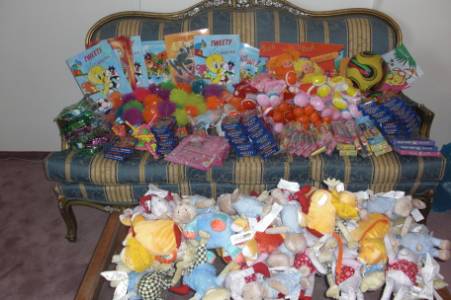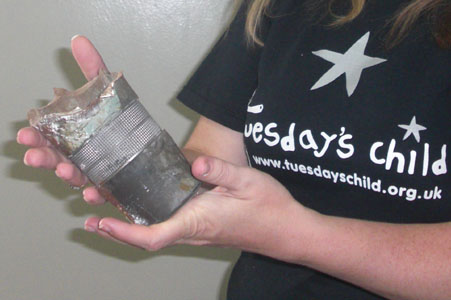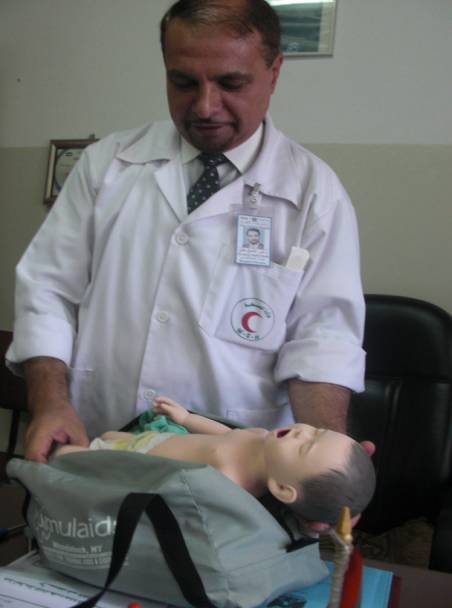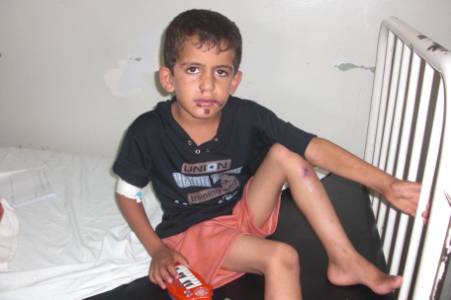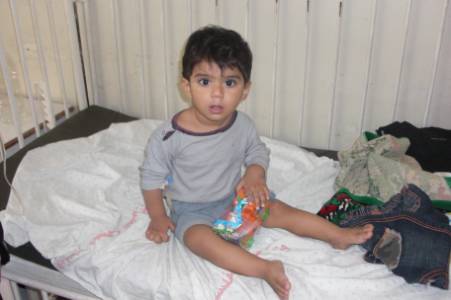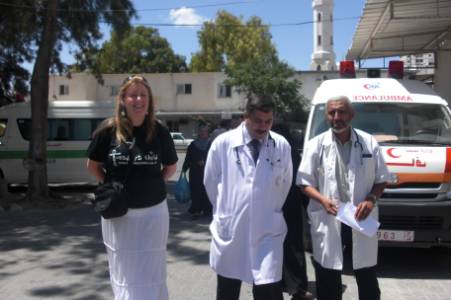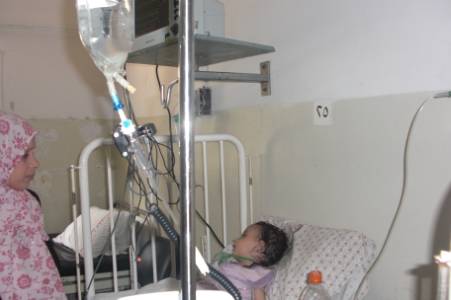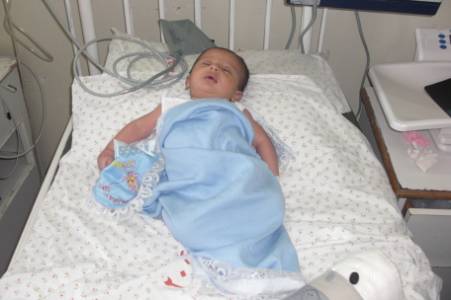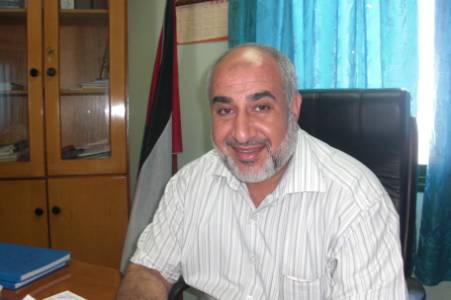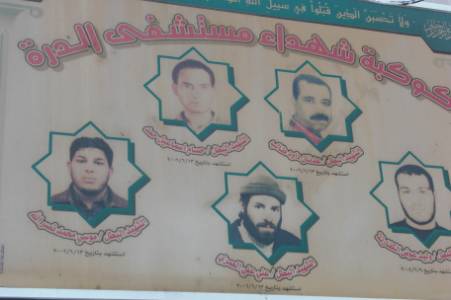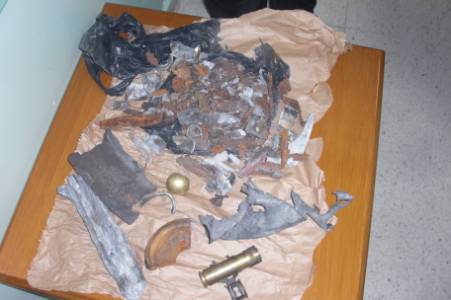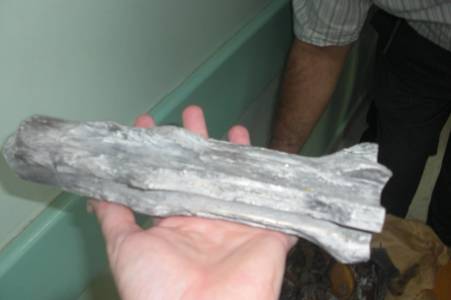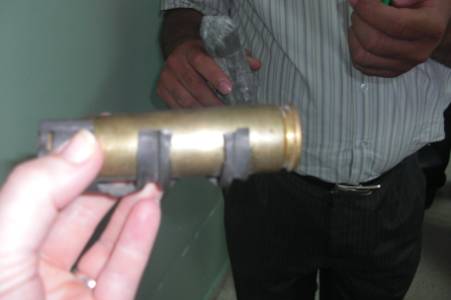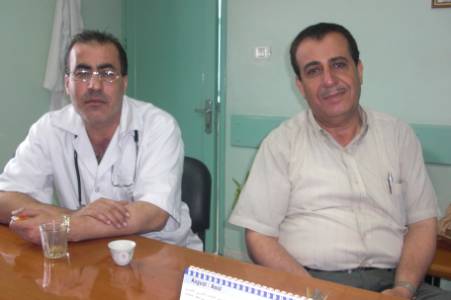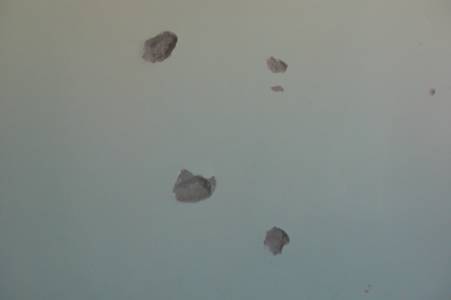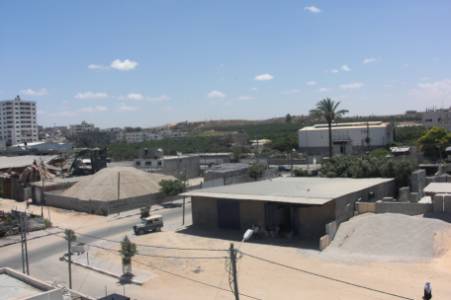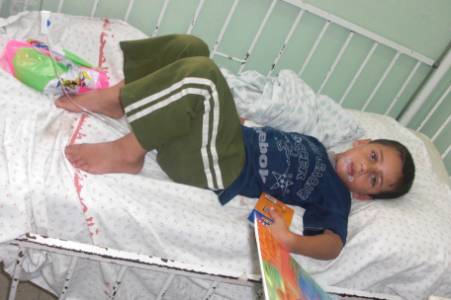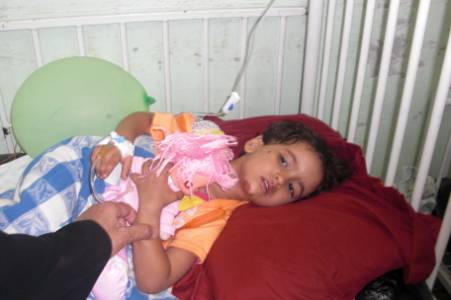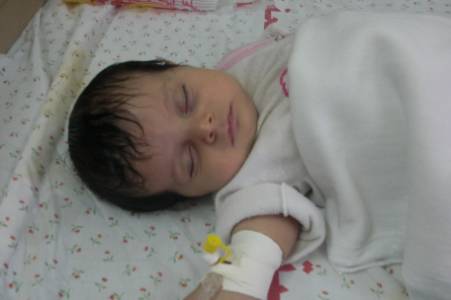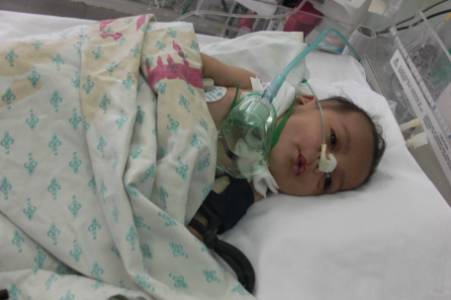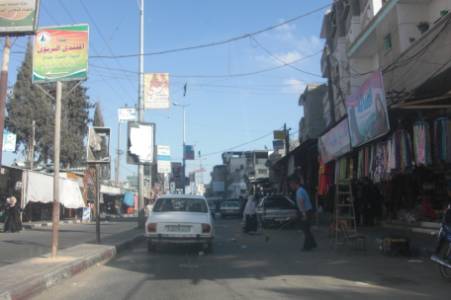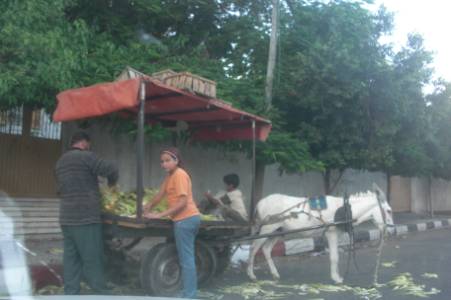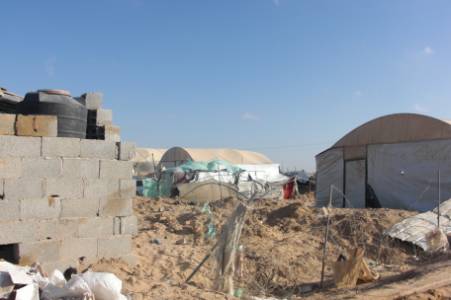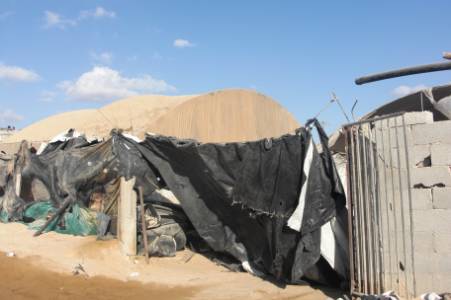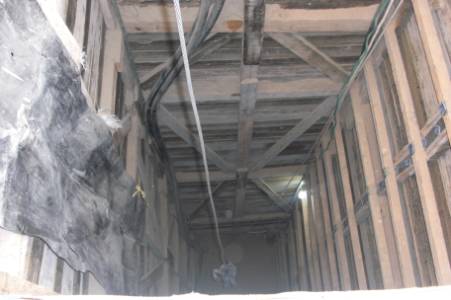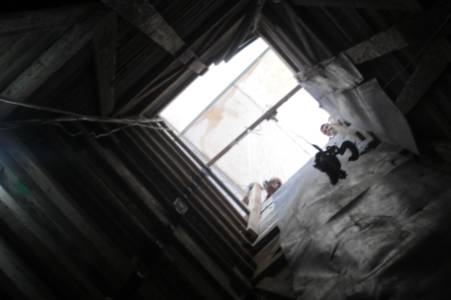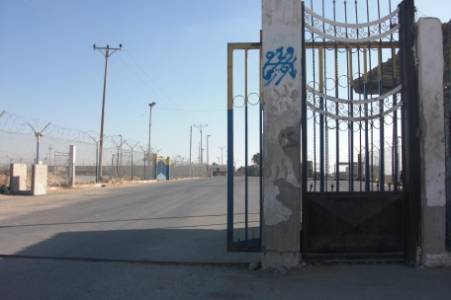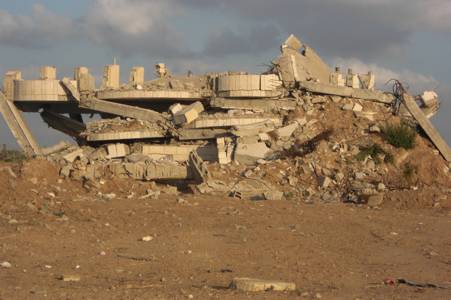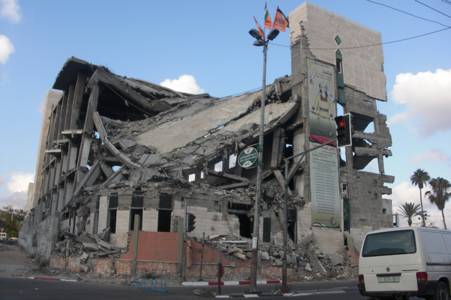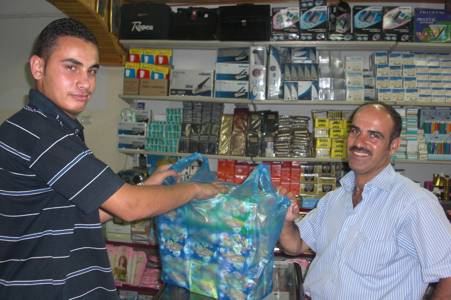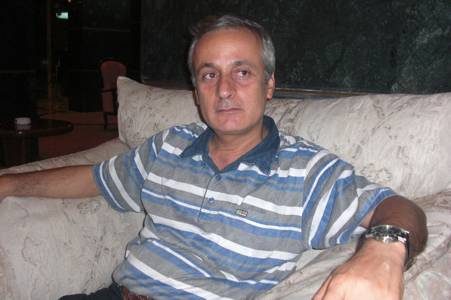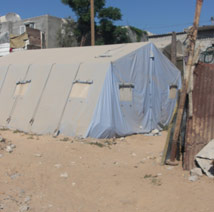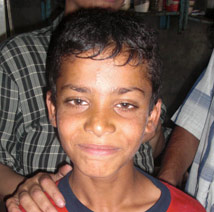


Tuesday’s Child Blog Tuesday’s Child Returns to Gaza – Day 9 Tuesday 14th July 2009 I get up at 6 a.m. this morning to sort the toys for the hospital visits. The water is cold as it as has been every morning. I am used to washing my hair in it now, although it would be nice, even one morning to have some hot water. Again, the things we take for granted. The word of the toy room in the hotel seems to have spread since last night and three staff call on me this morning to see if there is anything I need. As per last night, I give each some toys and sweets for their children. Breakfast is served to the room today although all I can manage, as each morning, a little dry bread and black tea. Looking out my window onto the beach, I notice an older group of boys are already running on the beach in twos, in their bare feet. I admire their discipline; they are doing circuits and it is good to see, as many I have met, in my 9 days, seem too fatigued and undernourished to walk any distance let alone run. I wish some of the young men and women I have met in their homes, still lying in their beds near lunchtime would embark on a similar exercise programme. However, I realise, many are still traumatised and overwhelmed by the suffering here and it is hard to have energy when you haven’t had breakfast and there is very little for lunch. I divide the toys into different age-groups for boys and girls and also the baby blankets and rattles for new babies.
My lift arrives at 9 a.m. My driver today is Ouni, Ahmed’s brother and it is great to see him again. Ouni looked after me during my last visit to Gaza. He is good fun albeit a bit crazy behind the wheel and I know filming today will be more difficult! He and his wife have just had their 4th baby, a little girl, now 4 days old. We load the toys and sweets into the car. These are simply a gesture to the children. Hopefully, when we visit the hospitals, we can assess their needs and see how else we can help in terms of provision of supplies. Ouni speaks of the war, the constant pounding and the never-ending wakefulness and the fear of sleeping. Both neighbours and friends were killed and he gives thanks that he and his family are safe. Incredible, the faith of many of these people and their constant thanks and praise of God, in spite of all they have endured, it is as if, the destruction of their civilisation here has drawn them closer to Him. We are welcomed at Al-Nassr hospital by the Medical Director and Consultant Paediatrician, Dr Anwar. He thanks me for our visit and invites me to his office for tea. He gives me background to, and details of, the hospital and hands me part of a rocket from his desk that came into one of the paediatric wards. It must weigh 30 kg, too heavy to hold in one hand. He shows me pictures of the hospital during the war, the damage caused and again this underlines the indiscriminate nature of Operation Cast Lead, for bombing and shelling hospitals full of sick children is despicable. What did these little children do to warrant it? “The hospital was hit in two separate strikes, 49 windows were broken and glass was everywhere, landing on the children in their beds. We evacuated two departments completely and also a number of the wards”, he explains. “The children were very afraid, some even ran out of the hospital and found their way home, incredible that they are still alive and how they ever found their way home in the mayhem, quite incredible. Al- Nassr hospital deals with chronic diseases, most of the acute injuries in the war were taken to Shifa hospital although many brought dead and injured children here. The main problem for children with chronic illness during the war, is that there was no transport available during the weeks of the war and people were staying in their houses with their sick children rather than bringing them to hospital. This meant that some children were presenting very late on in their illness e.g. meningitis and we had deaths because when children did finally present it was too late to intervene; also meningitis-induced necrosis requiring amputations, that may have been avoided had the children been able to get here sooner. Official mortality statistics during this war against civilians do not take into account other deaths resulting from the repercussions of the war and the enviroment”.
I ask about the most common conditions in children presenting to the hospital, currently. “We have 350 cases admitted per day to our casualty department”, he explains. “The most common problems are acute gastroenteritis, chest infections and meningitis. Meningitis is too common in Gaza and recently it has been reaching epidemic proportions. Other conditions we see commonly are anaemia in about 60 percent of all children and also rickets, due to lack of adequate nutrition across the population. There is little or no fresh meat, fresh milk or fresh fruit and the lack of these important foods is causing problems. The diet is high in carbohydrate and fat and low in protein and essential vitamins and minerals. About 10 percent of children have stunted growth. We also see a lot of inborn errors of metabolism however we have no facilities for a metabolic laboratory in Gaza and this makes management difficult. And there is a high incidence of congenital birth defects given the close sanguinity from close marriage here”. I inquire as to neonatal intensive care here and am alarmed to learn that there is no full total parenteral nutrition here (TPN) in Gaza and no surfactant for pre-term infants with respiratory distress syndrome. Such prescriptions are routinely available in the UK and Ireland and indeed in Israel. “We only have partial TPN here and this was a problem also during the war as many women went into early labour. Many women also lost their babies due to a much higher rate of miscarriage during the war; the official death figures from direct assault do not take into consideration the increase in indirect mortality”, Dr Anwar explains. I simply cannot imagine neonatal care without full TPN or surfactant therapy. I ask how the hospital manages for funding. “This is a very poor community, there is no money and so we try to help as much as we can”, Dr Anwar explains. “We rely on donations from NGOs and other organisations and paediatric hospitals in other countries help us with equipment, medicines, cereals and milk”. I ask about childhood vaccinations. “These are supplied by the WHO but we only have vaccination against haempohilus influenza, there is no vaccination against pneumococcus or meningitis in Gaza”. Dr Anwar explains that he has to go and teach junior doctors about neonatal resuscitation and refers me to one of his other consultants for a tour of the hospital and to distribute toys. However, he will send on photos of the hospital under attack and some of the children. I thank Dr Anwar for his time, he is clearly very professional and very committed to the children in his care. I guess with no full TPN or medicines such as surfactant, the need for infant resuscitation is much more frequent here.
Our tour starts with the acute admission wards and these are overloaded with children with acute infections, mainly gastroenteritis and chest infections. The accompanying paediatricians feel that many of these infections are related to contamination of filtered water and also the burden of lack of adequate sewage systems. Every bed we visit, mothers and family are also present and they help in the care of the children as staff are clearly over-stretched. Everywhere, mothers are bathing hot children with cool cloths. One little boy is really struggling, completely saturated and on oxygen, his respirations are very high and his breathing very shallow. “We cannot identify, some of the pathogens and are seeing some quite unusual fevers”, the consultant explains. I ask about the gastroenteritis and if it is coming from the sewage-rich sea. “Some of it is being picked up in the sea, but it is everywhere, the pollution, it is in the environment. The sewage is a big problem, also the garbage”. There are no civil services here to collect garbage and trucks are broken.
The toys and sweets are very welcome and as we go round, little faces light up with the unexpected gifts and sweets. Many children however, are beyond being able to play with toys and are much too sick. Everywhere we go, mothers are very appreciative and staff ask for toys for their own children. I will have to go shopping again! I use my alco-gel from room to room and ward to ward noting that there are no standard infection control or clean hands programmes here.
As we walk along one of the main corridors, a door bangs loudly, and everyone around me jumps out of their skin or crouches down. I am taken aback by the reaction, for it did not affect me nor did I even think twice about the loud bang, recognising it for what it was, a door slamming in the wind, as I walk ahead of the now dispersed group. Clearly, hospital staff here are still very nervy and jumpy and their response brings it home just how battered people’s nervous systems are.
We visit one ward where there are many very sick children. Everyone here has meningitis and they are very sick, explains the consultant. They are so very ill, every bed is a picture of struggle for survival. This is a first for me for I have never seen so many children with meningitis before, at the most maybe one child in isolation, but so many, it is hard to fathom. I ask for the statistics on child mortality for meningitis across Gaza and they offer to send them on. It is hard to believe that any country could bomb a hospital full of children, not once, but twice. “It was very clear the building was a hospital, we flew the hospital flag and also the flag of the red crescent”, one physician explains. If this happened in any other country there would be an international outcry.
We are also taken on a tour of the A & E department; it is crowded, there are children everywhere, many crying and the sweets are very welcome here. The staff are overloaded, doctors and nurses going between several children at a time and the statistic of 350 children per day hits home. It is crazy. The hospital itself is rundown, under-funded and badly in need of modernisation and better equipment. Also, there is little to suggest this is a paediatric hospital, unlike the many colourful and children’s themes in paediatric hospitals at home. I think of the clown doctors who visit children in Dublin’s paediatric hospitals; they could really do with them here! I am curious to see the pharmacy and the medicines they have. Also the neonatal unit, but we are out of time. I thank the doctors and nurses of Al-Nassr hospital for their time. Some children run after us to the car looking for new toys and more sweets or to change existing toys to something else. As we drive out of the hospital children and parents run alongside the car hopeful for more toys and sweets! We drive to the second paediatric hospital. It is now 12.15 p.m. and again today the temperature reaches 42 degrees. My face feels like it is melting. This hospital is the El Dorah paediatric hospital, first opened in 2000 and situated about 500 metres from the border with Israel. Here we are welcomed by the hospital director Dr Maged Hamada. El Dorah hospital is so called after a young boy, Mohammed El Dorah, who was shot in 2000 by occupying forces while in the arms of his father who pleaded for mercy, but he was killed regardless. In an attempt to cover up the murder, occupying forces put a skull cap on the boy’s head and attempted to claim he was a Jewish boy killed by Palestinian militia. A picture depicting the dying boy hangs in the wall of the hospital office, a 8 yr old martyr. That is a recurrent theme here in Gaza, twisting of events to cover tracks in advance of media coverage.
Outside the entrance, pictures of 5 hospital workers who were killed here in the hospital during Operation Cast Lead, including an ambulance driver. International humanitarian law provides that occupying forces must ensure the safety and well-being of the civilian population, yet this hospital was attacked on 3 separate occasions, 3rd, 12th and 13th January 2009, respectively. Dr Majed hands me two pages of pictures of the damage to the hospital during these two weeks. The pictures are horrific and incredible that more people were not killed here. “This hospital always suffers during any incursion, as we are so close to the border”, he explains, “We flew the red crescent flag and they ignored it; we were attacked by air and land troops. Apart from 7 of our workers, one baby in ICU died due to power failure and subsequent generator failure. A pregnant woman who was in labour, was hit by a shell and she and her baby were both killed. Imagine coming into a hospital to give birth to a new life only to lose both lives in such a violent manner”. Many of these stories here, never made the headlines. He shows me a selection of the remnants of war, collected around the wards of the hospital.
I ask about current presentations of children. “The most common presentations are gastroenteritis and chest infections and we estimate that the incidence of children coming in with severe diarrhoea has increased by over 100 percent since February. Children are also presenting with fever and we are unable to source the cause or the pathogen. We are also seeing a marked increase in meningitis and severe asthma. Child mortality from asthma increased during the war. We had a number of fatal asthmatic attacks, both on admission and as in-patients. There is also considerable concern now about the increased incidence of cancers in children, of all types, we refer these cases to Al-Nassr; these together with increased blood dyscrasias are raising questions about levels of radioactivity here”, Dr Maget explains. “We also see a lot of congenital heart disease, epilepsy and other neurological diseases and metabolic diseases; incidences of these are high here because of poverty and close sanguinity. In terms of paediatric nutrition we see too much anaemia, rickets and failure to thrive". Two paediatricians join us and there is a lengthy discussion as to the limitations with which they have to work and the needs of the hospital to treat children adequately. “We have a shortage of medicines for children, we lack diagnostic equipment, there is no MRI scanner and we have no facilities for transfer for specialist opinion and intervention. There are also no facilities for therapeutic drug monitoring of medicines with a narrow therapeutic range such as anti-epileptics”, one of them explains. “We also have cases that need immediate transfer for treatment. We have one little boy, Mohammed Mushtaha, he is 7 yrs old and he has myasthenia gravis. He is in extreme respiratory difficulty and needs urgent referral for treatment of pulmonary fibrosis. His older 3 siblings have already died of the condition here in Gaza and his younger brothers Mamoud and Ahmed, aged 5 yrs and 2 yrs also have the rare familial disorder. Mohammed’s case is the most urgent, he needs immediate referral. Every day we refer to Israel and every day they ignore our request”. I offer to take a photo of Mohammed and help raise awareness of his plight, however, he is at home today. His physician says he would be delighted for any help and promises to send a photograph on to me. I also suggest approaching Amnesty International to help make a case for this little boy who must be terrified that he is going to die like his older siblings. The paediatricians here say they have no access to outside agencies such as Amnesty International.
It must be very difficult to practice in such conditions. I cannot imagine for example, how a paediatrician or neurologist can treat epilepsy effectively without access to therapeutic drug monitoring facilities, this is out of the ark and puts the child with epilepsy at considerable risk. As for Mohammed, I would like to try and help this little boy before I leave Gaza, for even if I can help save the life of this child, the trip will have been worthwhile. We discuss the most recent war and the loss of life here again. The deaths of so many children is clearly a cause of great hurt and sadness to these paediatricians. The murder of innocent children has to stop and every citizen has a responsibility to do what they can to stop this brutality. I reflect on my trip last year, when I was told what was happening in Gaza is a slow genocide and they are targeting the children. Operation Cast Lead claiming the lives of 404 children (28%) is by far the most fatal incursion to date. The world has not moved on from the slaughter of innocents some 2000 years ago and I wonder have we come full circle. These figures for child deaths are for direct trauma and do not take into account deaths in children from other events precipitated by war e.g. asthma, epilepsy, preterm birth, meningitis, diarrhoea. Dr Maged takes us on a tour of the hospital and we give out gifts to some very excited little children. It is amazing how something as small as a toy or sweets can brighten a child. Children love to give and they love to receive even more. Parents ask us for toys for their other children and staff also for their children, we are inundated. Again, I am very impressed with the paediatricians here, they are very committed to the children in their care. As we walk around, I notice the damage to the hospital still and the bullet holes in the walls.
We visit the ICU ward where there are a number of children. We put on gowns but again, I note that there is no infection control here, in the form of hand gel sanitisation. One little girl, here is 4 months old, she suffers from intractable epilepsy and is in need of specialist referral. Again the requests are repeatly ignored while anxious parents look on. So very cruel. What did this little child do to warrant it, apart from being born in Palestine? It is bullying to the extreme. Big brave men, preventing access to emergency hospital intervention for a little baby girl. It is depraved and the ultimate breach of human rights. Also, one of the things I find most difficult to accept during this trip – large organisations busily collecting evidence of crimes against humanity, and still they continue, breaches are everywhere and there is clear indifference to the inhumanity being perpetrated by those same perpetrators others are trying to hold to account. And still in Gaza, the UN declaration of human rights failing the people here, most of all the children.
We finish at 2.30 p.m. and say good-bye to El-Dorah. So far, today have given out about 250 toys. I will definitely have to go shopping again as we have two more hospitals to visit as well as the camps, not the refugee camps but the many tents of displaced families. It is clear from today, how much children suffered in this recent war and indeed throughout the incursions by occupied forces. Both of these hospitals today are in great need and the most important help we can give is to try and raise awareness for the plight of these children needing transfer. Also the urgent need for intensive care medicines and drug assay materials. I also make a note to look into the possibility of sourcing vaccination against meningitis. We leave Gaza about 3.30 p.m. for Rafah, the city close to the border with Egypt. While we do not feed families this far south, I am curious to see the tunnels. I would also like to see this side of the Rafah border and the area we should’ve crossed in February, a few weeks after the war, when we were not permitted access with a medical team, medical supplies, medicines and children’s supplies. We stop in Khanounis to collect Sabah and drive on towards Rafah. We pick up two guys who work on the tunnels en route. One has just finished tunnel work to take a job with the summer games and one is still working on the tunnels. Both are friends of Ouni’s and hopefully our ticket into even one of the tunnels. There are 2,200 tunnels in Gaza, 1400 of which are currently active. “Tunnel work pays well and I can earn up to 50 US dollars per day for this kind of work. It is dangerous, but worth it”, explains one “and it will pay my way through college”. I think back to the first day of our attempt to cross Rafah in February and the Israeli F16s bombing the area of the tunnels, dangerous work indeed! I think back to Rafah and tell Sabah and Ouni, that I would gladly have come in through a tunnel if I could have found one and they laugh! They may have had to give me an injection of something, like the lion, but yes, I would’ve considered it! Rafah city itself is bustling and there are many street stalls here selling their wares. Shops seem to be much better stocked than in Gaza city, possibly because of the close proximity to the tunnels. However, the people of Rafah, as in all of Gaza have suffered through this war and for many years before it. Rafah, is also the scene of the murders of young international peace activists, 23 yr old Rachel Corrie in March 2003 and 21 yr old Tom Hurndall in January 2004. Rachel Corrie was killed when demonstrating against a house demolition of the home belonging to a local pharmacist. As we drive through Rafah, I reflect on her words a short time before she was murdered. “I feel I am witnessing the systematic destruction of people’s ability to survive....sometimes I sit down to dinner with people and I realise there is a massive military machine surrounding us, trying to kill the people I am having dinner with”, Rachel said. Six years on, her words remain accurate, except the killing has become more blatant and aggressive. Here too, Tom Hurndall, photographer and peace activist in the same movement as Rachel, was murdered, trying to save children caught in crossfire. Tom and Rachel apart, many Gazans have been killed in Rafah, over the years. In this most recent war, northern Gaza has sustained the greatest loss of life.
The tunnels start 500 metres this side of Rafah and go 1500 metres into Egypt. That would explain why I couldn’t find any at Rafah, I was far too close to the border and when I was walking around the fields there, I was probably standing above several. It’s quite a long distance across 1500 meters and the tunnel workers explain how they do it. A small car, I can’t remember the make, is taken down to its shell, so wheels, engine and seats and these run along the length of the tunnel. How do they get it down? They take it apart and re-assemble in the main road of the tunnel.
I have mixed views on the tunnels. Fundamentally, I am against them as they are destroying the economy here and a select few are making a serious amount of money out of the tunnel trade. Fair trade does not apply to the tunnel industry. Also, they are weakening the case for lifting the blockade and better access for humanitarian aid for all. However, speaking to the people on the ground, the tunnels provide a lifeline of food and supplies that is keeping Gaza alive. I think of the words of Ahmed a few days ago, “without them, we would all be dead” and there is no doubt about it, they enable more food and more choice to come into Gaza, albeit at higher prices. One of the tunnel workers tells us about the day he was sent down to pick up a monkey. I told him I heard about the lion but not the monkey and suggest he is pulling my leg, but he insists he is serious. “It was for the zoo, also”, he said, “and they sent me down, but when I went into the tunnel, I couldn’t see the monkey anywhere. I turned around to shout back to the guys that there was no monkey in the tunnel and the next thing it tapped me on the shoulder!” Now I know he is pulling my leg, but his friend confirms that he did indeed, hand on heart, bring a monkey up from the tunnel. I’m still not convinced. As we approach the tunnels, there seems no sign of fighter planes or trouble overhead. I ask when the last bombing raid was here and I am told there has been nothing for 2 weeks. Let’s hope it doesn’t start today again! As we drive along, there is tent after tent, rows and rows of them. Sabah explains that each of these tents is the cover of a tunnel. We stop at one, the guys work at occasionally, but the tunnel owner says no to an interview and photographs, as they do not want any coverage of their work or potential exposure of their site. Confidentiality is high on the agenda here and visiting journalists have caused problems. We discuss how much money some of the tunnel owners make here and I joke with Sabah that we should try and buy a Tuesday’s Child tunnel and put the proceeds towards humanitarian relief or else just not charge any mark up and bring whatever we want in – school uniforms, trainers, medicines, foods, good drinking water, lions! We drive on about 10 minutes to a second tunnel. Here the owners of the tunnel allow us to enter but on the strict agreement that there is no filming or photographs. This is a relatively new tunnel, as it was bombed and destroyed two months ago and several workers were killed. They take us to the shaft of the tunnel and I peer in, to a drop of over 50 meters and no wider than the entrance to my roofspace at home, lined by rows and rows of horizontal wooden slats. Incredible workmanship and quite an architectural feat. I am itching to take out my camera but they say absolutely no or the show is over. They outline how the tunnel works and offer me a seat and a trip down to the bottom. However, it is narrower than a child’s swing and given the 50 meter dark drop below, I chicken out. They kindly give a demonstration and one guy, sits on the swing, kicks off his shoes, and his colleagues lower him down to the bottom, I watch as he goes the whole way down to the bottom, getting dizzy even watching. It is a bit like ab-sailing really except you have a plank of wood under you as support, the rope pulley controls everything else. I ask what they have brought through today and they say “flour, rice, lentils, soft drinks and biscuits”. I talk with the guy who gave the demo and ask him, if he doesn’t find it frightening “it is a little, the first few times, but then you get used to it and it is routine”. I ask if it is dangerous, and he says “yes, ofcourse, many people have been killed here, but what option do we have, without the supplies we bring through, many people would die”. I ask what he finds the most difficult things to bring up and he says “for me, sheep and goats”.
I am still keen to get a photo so we go to a third tunnel the guys work at and we are in luck as the tunnel owner is not here for now but we have to be quick as he has only gone on a break. This shaft is not nearly as deep, only a quarter of the depth of the previous so it seems a bit of relative breeze to try out in comparison to the last tunnel. We manage to take a few photos and also a photo coming up from inside the tunnel. As we come out of the tunnel, others come over and ask what is going on, and there are some raised voices. We get into the car and drive away quickly. As we drive, the boys explain that this tunnel is owned by Hamas. Let’s go! Drive!
Driving back from the tunnels, I ask if we can go up to the Rafah border as I am curious to see it from the other side of the gate. We drive to the gate and take a photo, it is a far cry from the ornate gate on the Egyptian side. I think back to February and the sheer disappointment of not being allowed to cross this short distance of 1/4 mile after travelling all that way including 5 hrs across the Sinai desert from Cairo. I also think of the doctors and nurses I travelled with and the quietness in the car as we returned for Cairo and of Sabah waiting for me here at this side. Also, of Alan, the journalist who travelled with us and tried so hard to raise media pressure and also the guys in the Irish Embassy in Cairo who were so very helpful and pulled out all the stops. And all to no avail. The Gazan people are very disappointed in the lack of support from their Egyptian neighbours.
We drive back to Gaza city, dropping the guys home on the way. It doesn’t take long with Ouni at the wheel. We stop at a roadside shack barbequeing corn, the first thing I have been able to eat today apart from dry bread. It is very good. On either side of the road, scenes of mass destruction. We pass one building a former community hall for social gatherings and driving into Gaza, what is left of what was the new Ministry for Justice.
Time now for more toy shopping! I love buying things for children, and am used to buying in bulk and at hyper fast speed. I think back to one of my very first bulk buys in October 2006, 300 pairs of fleecy pyjamas from Primark for children in Bosnia. People at the check-outs must have thought the old woman in the shoe was on a buying spree. I often get strange looks, “IVF” I told one complaining woman once, behind me in the queue in Dunnes Stores , “it’s a nightmare when it goes wrong; I have 25!”. We return to two of the three shops we visited yesterday and here in Gaza there are no queues. This time in one, a new item, bubbles of all things, fantastic, so we take all of their stock about 150 bottles. I used to love bubbles when I was little, blowing all shapes and sizes and it is an easy toy for mothers to re-fill. We also take all of the stock of colouring books and crayons tonight, as these are probably one of the best options for the children in the tents, in terms of fun, practicality and longevity. We arrive back to the hotel laden down again much to the amusement of the porters who carry everything upstairs to my room and have a game of football along the corridor as they go.
It is now 8.30 p.m. and just time for a quick shower and change before my 9 p.m. meeting with Khalil Shaheen in the foyer. I still have severe diarrhoea and 6 days on it is very weakening. At least the vomiting has stopped. The last time I had something like this was in 2002, a cryptosporidium bug, when the Belfast water system was contaminated by local sewage. I am convinced it is the local bottled water. I am incredibly dehydrated. I will buy some watermelon tomorrow and try that to help rehydrate. Khalil arrives as planned. It is good to meet this human rights activist whom I kept in touch with during Operation Cast Lead, amazed to receive e-mail in all that was going on. Khalil is Director of the Palestinian Centre for Human Rights here in Gaza (www.pchrgaza.org). The work he did throughout the war was quite astounding, keeping regular bulletins and updates going, despite the long hours without electricity. He and his team have also worked hard to collate data since the war and followed-up every death during the days of Operation Cast Lead and since. Much of his work has informed large reports such as the Amnesty International Report on Gaza published on 3rd July 2009. Khalil comments on the similarity of our names, Shaheen and Sheehan, one typically Palestinian, one typically Irish. I much prefer being the latter, I couldn’t live without the occasional glass of pino grigio or a bottle of cold Carlsberg!
Just as we start to talk about the human rights breaches here in Gaza, we are interrupted. I have a visitor, Captain and Head of Security of the Ministry of the Interior - a formal visit from Hamas – it was only a matter of time. He does not ask if he can join us, he simply sits down and starts firing questions after a brief introduction. I explain I have little Arabic and as he has little English, I ask Khalil to kindly translate. He explains that he is Chief of Foreign Security Protection and responsible for the safety of all foreign visitors to Gaza. He tells me he is aware that I was formerly staying in a hotel close by and asks my reason for vacating it and moving to this hotel. He also asks many questions about the nature of my visit to Gaza, the duration of my stay, who I am travelling with and many specific questions in relation to our work in Gaza, to which I give very general answers. I tell him that in addition to our humanitarian work, we also work to increase advocacy to bring an end to the blockade here and for justice and freedom for the people of Gaza. That softens him a tad and finally he thanks me for the advocacy bit and leaves. I am in no way convinced that my safety is remotely enhanced by his visit and stated remit. I know enough to understand that he has not given me his correct and full name for the version given is too informal. Unfortunately, he has already left before I think of asking him as to the whereabouts of Shalit and if there is any chance I can bring him back to Israel with me on Sunday as an ice breaker to lifting the siege. I continue with my interview with Khalil. We talk at length about Operation Cast Lead, and I know, that in terms of statistics, this will be the one of the most exacting interviews during my visit, for Khalil is incredibly informed. I ask him first of all, about the first day of the war and if he can put into words what the 27th December was like for him. “At 11.30 a.m. Gaza came under the most terrifying attack; there were 250 military operations in the first 5 minutes from air and sea. The time was quite deliberate to target, firstly, the greatest number of children possible, for 11.30 a.m. is the time when schools change here and literally 2 lots of school-children would’ve been outside schools across the strip. Streams of F16 jets hit all public services and police installations, simultaneously. The noise was deafening and the whole street was quaking. Trees and lamp posts fell were uprooted. People, vehicles and donkeys and carts flew through the air. In one police academy, 50 young policemen graduating and almost all killed within minutes. I was walking to work at 11.30 a.m. and was half way between the Ministry of Finance in front of me and the prison behind me. A friend stopped me to chat and say hello and, had it not been for that chance encounter, I would’ve been 120 metres ahead outside the key target of the finance building. I often think of that friend and how his hello undoubtedly saved my life that morning. Hundreds of children were on the street, rushing and screaming in sheer terror. It was horrific. In front of me, people were flying in the air, over cars and higher than lamp posts, with the sheer force of the bombs and body pieces were tumbling from the sky. I remember one woman specifically, blown high into the sky, her clothes over her head and her underclothes revealed and being struck by the sheer indignity of it, especially for a Palestinian woman who dresses to cover even her arms and head. The ministry of finance was a key bombing site as it was surrounded by a hospital, 4 schools and 5 kindergardens”. I ask how he managed to keep the work and bulletins from PCHR Gaza going through such an assault. I followed his postings through the war and truly his work was remarkable. “Friends and colleagues, pressurised me to evacuate our building. I did not want to leave, but they were right. I went to my brother’s house and stayed there as he had a basement. My family and I were there for 17 days with very limited supplies of food and drinking water. There was no electricity and no water for washing and sleep was impossible. My brother’s house is close to where my uncle lives and, as his building has a generator, I went there to work briefly and to recharge my phone and laptop. One day, walking back with my uncle from his building, I was convinced we would both be killed. There were 4 apaches, low down, just above us, 5 drones and F16s swishing everywhere. We agreed to walk separately, 20 feet apart, that way less chance of us both getting killed. My heart was racing and the adrenaline was really pumping. An F16 dropped a bomb right beside me, it tore up traffic lights, but amazingly I was not hurt. I fell to the ground in a flash of multi-coloured light. For a moment I thought I had been caught in a white phosphorus bomb and I was gripped with fear. Words cannot describe it. I came very close to death that day. I remember seeing one old woman, the same day, hit with white phosphorus and literally imploding in flames. There was nothing I could do, it was horrific. The white phosphorus seemed to light up the sky before it hit and went ablaze”. I change the subject to the situation today and the breach of the human right of children to access health-care and share the cases of the two children in El-Dorah paediatric hospital. “This is normal here”, explains Khalil; “about 900 patients need referred out of Gaza monthly for specialist treatment and less than 10 -15 cases weekly are approved”. I think back to the man last year, Sabah’s brother-in-law, who died as there was no renal dialysis for him in Gaza; he drowned in his own fluids and toxins. Speaking of toxins, I move onto the problem with sewage. Pollution was a problem here before the war, the sewage services were breaking down, they need electricity to work, and the constant electricity cuts, made this impossible. That apart, sewage needs to be chemically treated and there are no materials for this. “About 40-50 million cubic tonnes of raw untreated sewage have been pumped into the sea here since the war”, says Khalil. “A recent study tested the sea water and found 7 hot spots with dangerously high levels of sewage and people now using the beach have been warned to avoid these key 7 areas, but they are still exposed. The problem with the sewage works here is that, like everything else it is run-down, and in need of repair and maintenance. There is a shortage of sewage pipes, equipment, spare parts, chemicals to treat sewage and then the daily power failures make things very difficult”. “The electricity failures here also have a huge impact on daily life and they are very disruptive. There is currently electricity for 12 hrs daily, so much better than it was due to a new linkage to Egypt. This week for example, there has been no electricity between 8 a.m. and 4 p.m and then it comes on between midnight and 8 a.m. Then the following week, it will change again. It makes it impossible to plan. That’s one of the problems here, there is no freedom and you always aware of the pressure, the control being exerted on how you choose to live. For example, you might be watching a football match on TV and enjoying it and next think the electricity goes off for 8 rhs and you miss the rest of the match. It is incredibly frustrating. The electricity cuts have a huge impact on hospital services. Last week, I was in Shifa hospital for a meeting and the electricity failed 7 times in 40 minutes. This is impossible for physicians to work with – monitors, equipment in theatres, ventilator support. All hospital equipment need electricity and the generators cannot cope. And some areas are completely without electricity or at most 2 hrs per day". “Another problem here is that the majority of people live in high buildings of 7 floors or more. All of the water into the apartments is pumped by motors and so, when the electricity is off, there is no water supply. The power and water failures are especially problematic for old people living alone. It is very stressful. The whole goal is to disrupt daily life here as much as possible. It can be very frustrating”. I can identify with the frustration bit as patience is not one of my virtues. I am not here two weeks even and the constant power failures are incredibly frustrating, also the unreliability of the internet, the weak signal when you can get it and the snail slowness of email. Also, the current seems weak, it takes forever to recharge my mobile phone, camera and laptop. Even drying your hair is difficult here, the first hairdryer disintegrated in my hand, just fell apart onto the floor and the second exploded, much safer to towel dry! Everything is broken in Gaza. Still, I should be thankful, no cockroaches this week. I ask Khalil, what is his view, is the greatest breach of human rights here in Gaza. “Undoubtedtly, it is the lack of freedom and the feeling of imprisonment. For example, I would like to take my mother to Egypt for a holiday, but it is impossible to cross and requests for permits are refused. I haven’t seen any of my two brothers or sisters in 2 years and they are unable to visit their mother here in Gaza. Parents and children should be free to visit each other. People living in Gaza are unable to go to parents’ funerals in the West Bank. Students here lost a year of their education and many decided to leave university. Even just to have the freedom to go and watch a football match!” I hadn’t realised Gaza had a football team. “We don’t, but Palestine has and half of the players are from Gaza. We lost 0-4 there to Iraq. We can’t go and watch them and players from Gaza only get to be with their team mates for 2 days before any match, so team training is impossible. It’s ridiculous!” I think of the human right to play and leisure and the freedom of people in all other countries to follow their chosen sports teams. I ask if his children follow football also. “My youngest son, is a Barcelona fan. I would love to be able to take him to watch a match. I would love to do a lot of things, but living a normal life is just not possible. I ask about his other children. My older son is 16 yrs old, we call him “the rapper”. He is very good and he has his own page on myspace – Amyn Shaheen”. I make a note to send him an email and friend request from the Tuesday’s Child album Myspace. Football and rapping, regular kids, but trapped in a miserable controlled existence and missing out on their youth. I ask, in terms of Operation Cast Lead, apart from the obvious lack of regard for life and so many deaths, what, for him was the worst breach of international humanitarian law. “There were so many breaches of international humanitarian law. For me, personally, the recommendation by Israel in advance of the attack, to people to evacuate their homes, but where could we go, the border with Egypt and Israel remained closed, we had nowhere to go to. In 25 miles of land, where were we possibly to go to. There was no place safe. When people did evacuate their homes, they were shelled and fired on, many were killed doing just what they were told to do. Israel dropped leaflets in advance of the 27th December 2009 saying to the effect – we are coming to destroy Hamas, evacuate your homes. For me that was the worst. It is very clear for the world to see that this was not a war against Hamas, this was a gross assault on Palestinian civilians, a collective punishment of the people of Gaza. UNRWA schools were immediately converted into shelters, considered safe havens, they were marked with blue flags and all locations were given and to Israel and they bombed the UNRWA schools”. “And still given all we have suffered the blockade and the persecution continues. The blockade is more robust than ever and access for humanitarian aid is increasingly limited. In 2005, 450 trucks came to the area daily, mostly with food and now it is less than 70 per day, sometimes as low as 20 trucks”. I raise the matter of the tunnels I visited today and ask his opinion on these. “Like you, I am fundamentally against the tunnels, they are a breach of fair trade, yet they are essential to life and survival here. However, as with any black market, there is a lot of volume, but the quality is very poor. Take for example, other things apart from food, like fuel – 1L of fuel here costs 40 shekels (12 USD) and yet the quality is terrible and the cars are affected”. Also, people’s health from pollution and by-products, I suggest. Last year, there was no fuel at all, people tried to run their cars on cooking oil and many seized up. “Even, the rubble, it is every where, we need equipment in to clear it. Buildings are collapsing and killing people. We need materials to rebuild homes, people can’t exist in shacks and tarpaulin tents forever”. I ask about compensation for all victims and if that will be possible. “Our organisation is currently demanding compensation. We are following up on every war crime committed”. I ask if he is pleased with the Amnesty International Report and the awareness it is raising. “Yes, it is a good thing, much of their information was provided from our own work here. Anything that can raise awareness will help. We are publishing a final report on the website soon, featuring 100 families who lost loved ones in the war”. I wish Khalil good luck with that and I look forward to reading it. I ask finally, what the solution is for Gaza. “An end to the blockade and a one state solution which provides equality and justice for all” he says. “The main problem we face is the political divide here now, it is deep and without unity we have no hope”. I hope that his vision will become a reality. I say goodnight to this incredible champion of human rights for his people. He deserves more acknowledgment for his tireless work. Check out his website at www.pchrgaza.org It is now 11.30 p.m and I could really do with a cold beer. Today has been very busy, two paediatric hospitals, the toy distribution, the Rafah tunnels, more toy shopping, a visit from Hamas and a 2 hr meeting with the Khalil and now my blog to update. Full on. Tomorrow morning I will visit Shifa hospital. Even the visit from Hamas tonight is not enough to keep me awake. I am shattered. How did people here go without sleep for 28 days? I think of all the injustices of the day, the wealth of evidence for the cruelty of daily living under this imprisonment and the sadness of the indifference of so many to their plight, most of all the media. I am frustrated with God tonight. Where are you in these people’s lives? I know you require suffering, but come on, these people have had enough. No more. This has to stop and You have the power to stop this in an instant. I think of the little 7 yr old boy Mohammed, struggling to breathe from a disease that has already taken the lives of his 3 older siblings and yet referral for life-saving treatment continues to be refused. How terrified this little child must be feeling tonight. I ask my guardian angel to visit his guardian angel and give him my love and my promise that I will continue to try and help his case be heard. Also, of the parents of the baby girl in ICU needing referral and all the children with life-threatening meningitis. And then the more simple hopes and dreams of watching Barcelona play live in Spain, or anywhere, or going to support your national football team or take your mother on holiday. I open Direction for Our Times looking for an answer. “I the God of All Creation, can slap down and destroy evil with a glance. I allow a certain amount of evil to co-exist because my children can then discern light from darkness, in the same way as a child is taught to learn to discriminate between cold and hot. Children, if you desire to blame Me for the state of the world, your ancestors in heaven will bow their heads in disappointment. Do not be so ridiculous. I do not will catastrophe upon my children. I do allow a certain amount of upheaval so that attention will be focused away from the ever present diversion of material goods. In line with this goal, I will remove many material comforts. Consider this a liberating experience. Your losses on earth are nothing in comparison to the loss you will experience if you choose darkness”. That’s me told. I tell Him, that I am looking forward to His glance on Gaza! I am sorry for my anger. “God my Father, help me to understand”. If you are in a position to help any of the families we met during our time in Gaza, please contact us at info@tuesdayschild.co.uk or donate online here » |
||||
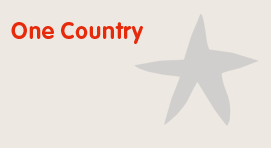 |
Country Spotlight: Egypt... The Holy Vincent of Paul School, Aboule Darde, Alexandria is a primary school catering for 400 children, both orphans and an intake from the poorest of the poor families in the region. The school provides education and full meals to all children. They are urgently in need of funds to sustain services (the right to education, the right to health). Find out more about the Countries we help... |
Tel: +44 (0)289 050 2725 | Mobile: +44 (0) 7545 452362 | Email: info@tuesdayschild.org.uk | Terms
